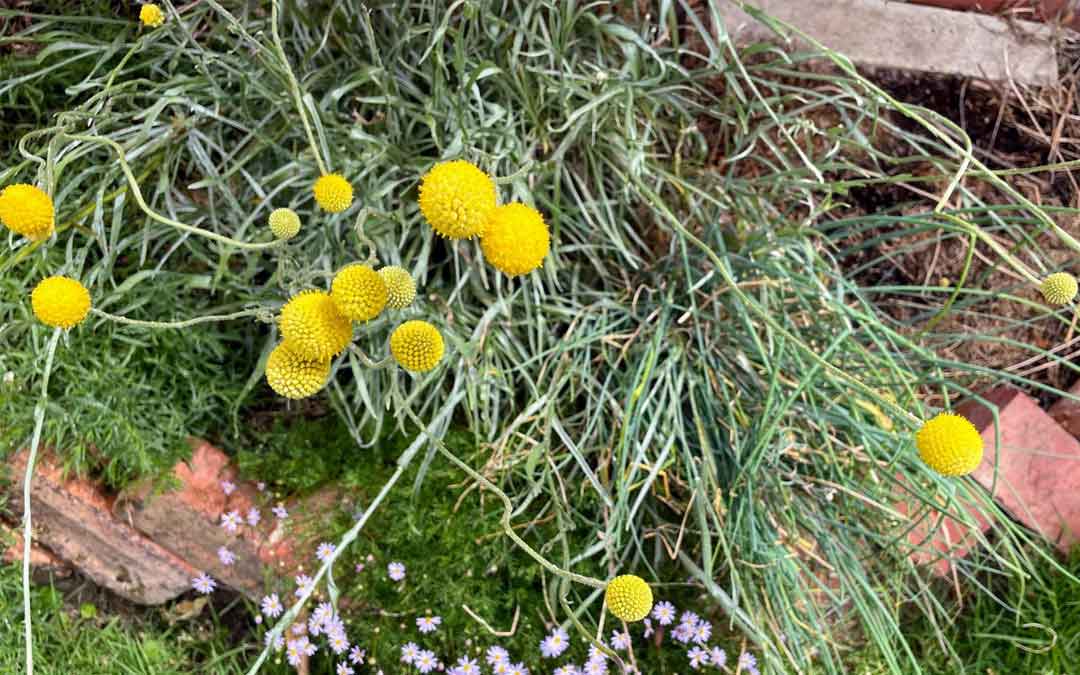Five reasons why you should plant Billy Buttons

Summer is full of amazing flowers – dahlias, alyssum, chamomile, sweetpeas, cosmos, grevilleas, banksias, echinaceas, zinnias, marigolds and so the list goes on. Sunflowers are a long-time favourite summer stunner, but I reckon Billy Buttons are also at the top of my list of summer flowers that make me happy.
Six native species form the group of plants known as Billy Buttons or Drumsticks. Pycnosorus globosus is the most commonly found in nurseries and available as seed. While it’s not locally native to Macleod, it is to Melbourne’s western Plains Grassy Wetlands including around Altona, Werribee and Melton, so it’s not far out of its indigenous range.
1. Eye candy in the garden
Billy Buttons are simply stunning in your garden or pots. Hundreds of tiny flowers form striking spherical heads that sit high above beautiful grey leafy foliage. The first yellow flowers appear in spring and they bloom right through summer and well into autumn – providing about half a year of stunning colour. I have one planted behind a gorgeous locally native purple flowering Cut-leaf Daisy (Brachyscome multifida) and it’s a beautiful colour combination.
2. Here for a good time – and a long time
Unlike their distant American cousins the sunflowers (both are in the Asteraceae family), the Billy Buttons sold in nurseries are perennial, instead of annual. This means they don’t need to be replanted each year like sunflowers, but will rebloom when spring comes around again. All you need to do is remove any dead flowers and prune after it has finished flowering to neaten it up and promote strong new growth. If on the off chance it dies off during the cold months, it will likely resprout when spring arrives.
3. Made of tough stuff
Billy Buttons and sunflowers are both low-maintenance, high-reward plants to grow. Billy Buttons can cope with heavy soils and don’t mind being occasionally flooded or waterlogged. They like sun or part shade (4+ hours of sunlight a day) and apart from watering they require basically no care. Unlike sunflowers, when you snip stems off a Billy Button it extends the flowering time. If you aren’t keen to put them in a vase (see below) deadhead any faded flowers so it keeps sending up new flower stems. You don’t need to fertilise Billy Buttons, because they are adapted to Australian nutrient-poor soils. If you do want to give them a boost make sure it’s a diluted liquid fertiliser like Charlie Carp or Powerfeed, or a low-phosporous native plant fertiliser. They aren’t particularly fussy about soil pH, but avoid planting in strongly acidic soils. They are tolerant of light frost and despite coming from wetlands cope well with dry spells in garden rockeries, but will always do better if you give them some water in warm weather. They don’t seem to suffer from any fungal diseases and the only pests I’ve had were some slugs and snails when I first planted out my seedlings.
4. Vase-worthy for years to come
Both sunflowers and Billy Buttons look stunning in a vase. Sunflowers will droop and their stems will go slimy in vase water within a week or so. Billy Buttons however, can be snipped from the plant and hung upside down in a warm, sheltered spot away from direct sunlight for a few days to dry. They will then remain stunning yellow balls on firm straight stalks for years and years as dried flowers (great for cheering up inside in winter). They are sold by florists and many people buy them online for up to $50 for a bunch of 10! I’ve picked about 50 stems from one plant over the past couple of months (it loves being regularly picked) and it has another 30 or more stems on it. I’ve wrapped a couple of presents lately in brown paper and tied a Billy Button with twine on the front which has delighted my friends.

5. Wildlife attracting
Both sunflowers and Billy Buttons are wildlife-attracting. Sunflowers particularly attract cockatoos which have a ball destroying the flowers so they can eat the seeds. Billy Buttons however are a wonderful butterfly, native bee and pollinator-attracting plant. I have my Billy Button (and I’m about to plant 3 or 4 more) and my Cut-leaf Daisy planted below my 18-month-old espaliered apple trees to try and boost pollination so they bear me more fruit in the years to come.
If I’ve convinced you that Billy Buttons deserve a spot in your garden, now is a great time to plant seed either directly into the garden or in seed trays. You can buy seed (and plants in pots) at most plant nurseries, including Bulleen Art and Garden and Bunnings.
Words and photos by Jen Willis
